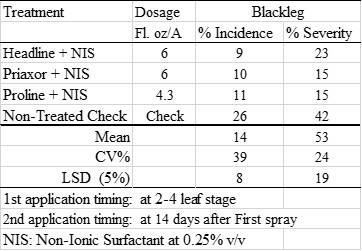The research trial was conducted at the Langdon Research Extension Center. The trial was planted on May 9th, 2016 with the canola variety “DKL 30-42 (Roundup Ready)” in a randomized complete block design and replicated four times. The trial location followed recommended practices for land preparation, fertilization, seeding rate and weed control.
The plot size was 5 ft. wide x 16 ft. long with a canola border between each plot. Two applications of fungicides were applied at the 2-4 leaf stage and 14 days after the first application using a CO2-pressurized backpack style sprayer with a three nozzle boom (XR-8002) at 20 GPA. The level of blackleg obtained was completely from natural infection. The severity of blackleg infection was evaluated on 100 plants averaged over four replications after swathing on August 22. Individual plants were uprooted, cut through the basal part of the stem and scored on the percent of diseased tissue visible in the cross-section. The ratings were zero when no diseased tissue was visible in the cross-section, and 100 if the diseased tissue occupied 100 percent of the cross-section with significant constriction of affected tissues, drying of tissue and brittle or the plant was completely dead. The results indicate there were significant differences obtained among the variables tested when compared with that of the non-treated check. There were no significant differences observed among the fungicide treatments in blackleg incidence or severity levels, however, all the fungicide treatments were significantly differing in blackleg incidence and severity levels from that of the non-treated check.
Yield data (not shown) was impacted by excessive rainfall during the crop season that resulted in the development of white mold. A blanket application of fungicide was not applied for white mold control at bloom stage. Yield results are unreliable because any yield differences observed among the treatments cannot be attributed to a specific disease.
